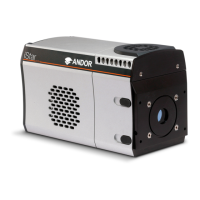Safety and Warnings Information
ADDITIONAL NOTE - AVOIDING DAMAGE TO THE NEW ISTAR DETECTOR
An ICCD is a very sensitive instrument, though with care and good working practice, it should last many years.
1. There are two major potential forms of damage to be considered:
• Bleaching of the photocathode brought about by over-illuminance of this photo-sensitive interface
Bleaching of the photocathode reduces the Quantum Efciency (QE) response (it can render it completely
unresponsive) and permanently increases the background noise of the Image Intensier.
• Ion damage of the cathode brought about by excessive numbers of photoelectrons in the Multichannel Plate
(hereinafter referred to as the MCP). As a general rule of thumb, when the CCD is already saturated, this type of
damage is liable to occur.
Excessive numbers of photoelectrons in the MCP brought about by excessive input light levels, or moderate
light levels and excessive gain can damage both the photocathode, MCP or the phosphor screen.
If the multichannel plate is overloaded with incoming electrons, it is much more likely for positive ions to
be knocked out of the walls of the multichannel plate by the colliding electrons. These ions are accelerated
towards the photocathode and can do considerable mechanical damage.
Excessive electrons can also increase the outgassing rate inside the tube to the point where the vacuum is
seriously diminished.
The protection circuitry in the New iStar monitors the current drawn by the phosphor, which is indirectly linked
to the incident signal intensity as seen through the MCP gain chain. Above a certain level the high voltage
power supply at the MCP shuts down to prevent damage. However, when only a sub-section of the phosphor
/ photocathode is illuminated, damage can occur without the high voltage supply shutting down. Applications
involving focusing of strong spectral line features, or conned bright spots in a imaging scenario must therefore
be treated with appropriate caution.
The following best practices should be observed:
• AlwaysmaintainthemeasuredsignalbelowthesaturationleveloftheCCD.Thisshouldconstituteasafe
operating condition in most circumstances.
• Donotfocusfeaturesof<50μmonthephotocathode(i.e.stayaroundtheresolutionlimitoftheNewiStar).For
example,a10μmfeaturemightbesufcientlyintensetodamagethephotocathodebut,whenitissmearedout
to~50μm,itmaynotbesaturatingtheCCDandthereforesatisesthegeneralguidelineabove.Thisapplies
to images and to spectra. Be particularly careful with automatic spectrographs that reset themselves with the
brighter zero order on the center of the focal plane.
• Alwayskeepthephotocathodecoveredwhenthedetectorisnotinuse(thephotocathodewilldegradeeven
when switched off). This can be facilitated by using a mechanical shutter whenever possible.
• Ifuserisunsureofthesignallevelstobedetected,oneshouldstartwithlowsignallevelsandbuildup.At
minimum gain, the sensitivity of the New iStar is similar to a front illuminated CCD, so if necessary, use a CCD
detector to check the signal level.
• UsershouldprotecttheNewiStarfrommechanicalshockbothinuseandintransitasdamagetotheintensier
tube may result from sharp jolts.

